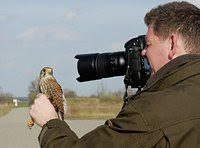
Tuesday, December 22
Tuesday, December 15
Tufted ducks



After a few weeks of lousy 'grey' weather, winter arrived in Holland! Since a few days it's freezing and the weather forecast for tomorrow predicts snow. Time to take the cameras outside. Last sunday, I visited the harbour of Harderwijk. A juvenile common loon was using this harbour as its winter residence. The loon wasn't too much interested in playing the leading part. It was present but remained at intermediate distance from the interested photographers. The leading part, at least for me, was played by a couple of tufted ducks. By choosing a low angle of view, it was possible to obtain intimate portraits of these beautiful birds. They were quite cooperative as they took a rest just a few meters from me. Well, it was only a small nap ...... just have a look at the attentive eye!
Cheers, Dirk-Jan
Thursday, November 19
Cranes at Diepholz, Germany














Thursday, November 12
A view from the past


Best regards,
Dirk-Jan
Wednesday, November 4
Fall in our backyard

Tuesday, October 27
Fall(en) bears in Finland
Fall is taking our country step by step. Brown, orange, yellow, and red tones are dominating our landscapes. Lots of mushrooms, migrating birds ..... an interesting period full of photographic motives. Before we post some pictures of our current fall adventures, I'd like to post some older news. About 4 weeks ago I spend a few days together with Bendiks Westerink (http://www.bendiks.nl/) in the Wild Brown Bear lodge. Our goal was clear. We liked to take pictures of brown bears in fall colours. Some beautiful pictures were already made in our minds. Fall colours, fog, bears, sphere ......... you know. Our timing was right. After we arrived at Helsinki airport it was clear that fall had arrived in Finland. The more we drove to the north, the more intense the colours became. In particular the birch trees were coloured intensely yellow! What could go wrong? After arriving at the lodge at about 2 o'clock in the afternoon, we had a quick meal and departed full of expectations for our first bear night.

Bendiks waiting for the things to come
When I visited this place last July there were at least 6 individual bears each night and they came already early in the evening. But what happened to the bears in the meantime? The hours passed and dusk came ...... no bears. Our first bear night wasn't successful. To make a long story short on the last of our three nights we only saw one bear in twilight. Was it the hunting season? Was it the abundant presence of natural food? I don't know ..... but there is one thing I learned ..... these brown bears are wild creatures that are not listening to the ambitious dreams of wildlife photographers. Let's keep it like this!
Didn't we take any pictures? Sure we did. A cooperative red fox, a common teal, and of course the beautiful fall colours in the land of the thousand lakes.



Cheers,
Dirk-Jan
Tuesday, October 6
Scandinavian summer (epilogue)


The second night was spend in one of the two forest hides. My first impression was not very positive. The small hide wasn't hygienic. It smelled horrible like a bad mixture of moulds and urine. Time to open the small windows! I had to choose between several bad options. Mosquitos, hungry bears within a meter from the hide, or that irritating smell. While I was awake I preferred the open windows. The forest hide was situated in an area that obviously suffered by the dense bear population. The ground vegetation was demolished and mainly gone. I was pleased to get out of the hide the next morning, luckily with some interesting pictures.


The last night in the pond hide more than compensated for my disappointing forest experience. That evening, the weather and light conditions were excellent. The temperature was about 20-25 degrees Celcius, which turned the brown bears into enthusiastic swimmers. After 6 hours of continuous concentration, excellent wildlife photography, and 16 GB of CF cards, I decided to call it the day. Sweet dreams about an unforgetable summer holiday in Finland and Norway!


Cheers,
Dirk-Jan
Tuesday, September 15
Scandinavian summer (part II)

The fjell landscape in the central part of Varanger during midsummer night. During those nights the light is very special with intense yellow, orange to red tones. The lakes are home to loons and long-tailed ducks.

A complete rainbow remained visible for over an hour during one of our midnight drives through the arctic tundra. I like the two arcs in the picture. The atmosphere was complete with the typical calls of some characteristic arctic bird species.

A territorial golden plover in its biotope.

Lapland bunting, a common resident of the tundra uplands.

Adult ringed plover backlit by the midsummer night sun.
The Vardø area: scenic rock coast at its best

View on the spectacular route towards Hamningberg, an abandoned fishing town along the Barentsz sea. It is like driving through a moon landscape. Don't forget to eat the waffles in Hamningberg. The best in Norway!
The tectonic plates almost rise perpendicular from the earth surface. Every second, the massive stones are beaten by the inevitable surf.

Hopefully you enjoyed the pictures. Questions? Please feel free to contact me on info@ifornature.nl. I would be pleased to help you on your way to Varanger!
Dirk-Jan
Saturday, September 5
Scandinavian summer (part I)



Saturday, August 29
Still alive?

Happy shooting,
Dirk-Jan
Friday, May 8
Black grouses in Finland (III)
As promised, I'm posting the last part of the Finland story. This one is about the other bird species. At the lekking sites of the black grouses, several other species were present. The cranes had just returned from their wintering grounds. They stayed far away from our hides, but their territorial calls added a special accent during the early morning hours. At one occasion a couple of whooper swans came flying over our hides with loud calls. Luck was on our side as they decided to land just about 50 meters in front of our hides. After some grooming they flew away and I managed to get sharp pictures of their take off.

After the black grouse sessions, we spend the rest of the day to search for other bird species. You can imagine that we also needed some rest in the afternoon after getting up at 2.30. Our Finnature guide Ari Latja drove us along the hotspots in the Oulu region. We observed groups of cranes and whooper swans on the fields, capercaillie and crossbills in the forest, as well as a group of three moose. Finland is well-known for its owls and woodpeckers. A resident black woodpecker gave a nice show and we were lucky that Ari found the largest and the smallest member of the Finnish owl family, the magnificant great grey owl as well as the pygmy owl. Both gave us unforgetable moments.



Thanks for visiting this site. Hope to see you back!
Dirk-Jan
Friday, May 1
Black grouses in Finland (II)


Monday, April 27
Black grouses in Finland (I)



impressing behaviour

fighting for the territories
 posing female
posing femaleThere is more to come in the coming two weeks. Later this week I will post some backlight pictures of the grouses. The other birds of this Finland trip will follow next week. Hope you liked it so far. I'm looking forward to see you back on the blog and please feel free to leave your reaction/feedback.
Dirk-Jan

